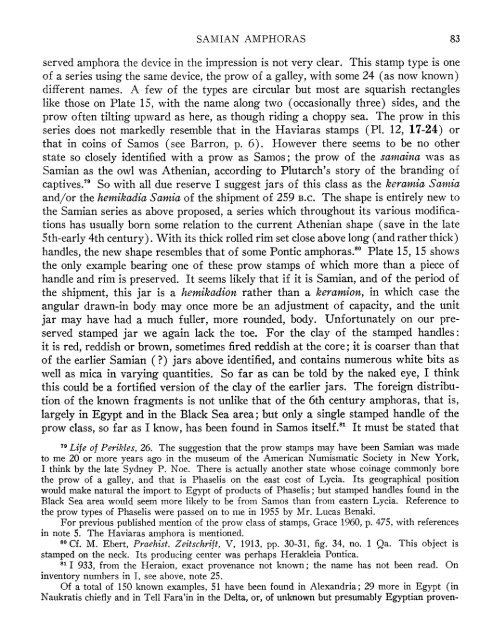SAMIAN AMPHORAS - The American School of Classical Studies at ...
SAMIAN AMPHORAS - The American School of Classical Studies at ...
SAMIAN AMPHORAS - The American School of Classical Studies at ...
Create successful ePaper yourself
Turn your PDF publications into a flip-book with our unique Google optimized e-Paper software.
<strong>SAMIAN</strong> <strong>AMPHORAS</strong> 83<br />
served amphora the device in tthe impression is not very clear. This stamp type is one<br />
<strong>of</strong> a series using the same device, the prow <strong>of</strong> a galley, with some 24 (as now known)<br />
different names. A few <strong>of</strong> the types are circular but most are squarish rectangles<br />
like those on Pl<strong>at</strong>e 15, with the name along two (occasionally three) sides, and the<br />
prow <strong>of</strong>ten tilting upward as here, as though riding a choppy sea. <strong>The</strong> prow in this<br />
series does not markedly resemble th<strong>at</strong> in the Haviaras stamps (P1. 12, 17-24) or<br />
th<strong>at</strong> in coins <strong>of</strong> Samos (see Barron, p. 6). However there seems to be no other<br />
st<strong>at</strong>e so closely identified with a prow as Samos; the prow <strong>of</strong> the s<strong>at</strong>maina was as<br />
Samian as the owl was Athenian, according to Plutarch's story <strong>of</strong> the branding <strong>of</strong><br />
captives."9 So with all due reserve I suggest jars <strong>of</strong> this class as the keramia Scamia<br />
and/or the hemikadia Samia <strong>of</strong> the shipment <strong>of</strong> 259 B.C. <strong>The</strong> shape is entirely new to<br />
the Samian series as above proposed, a series which throughout its various modifica-<br />
tions has usually born some rel<strong>at</strong>ion to the current Athenian shape (save in the l<strong>at</strong>e<br />
5th-early 4th century). With its thick rolled rim set close above long (and r<strong>at</strong>her thick)<br />
handles, the new shape resembles th<strong>at</strong> <strong>of</strong> some Pontic amphoras.80 Pl<strong>at</strong>e 15, 15 shows<br />
the only example bearing one <strong>of</strong> these prow stamps <strong>of</strong> which more than a piece <strong>of</strong><br />
handle and rim is preserved. It seems likely th<strong>at</strong> if it is Samian, and <strong>of</strong> the period <strong>of</strong><br />
the shipment, this jar is a hemikadion r<strong>at</strong>her than a keramion, in which case the<br />
angular drawn-in body may once more be an adjustment <strong>of</strong> capacity, and the unit<br />
jar may have had a much fuller, more rounded, body. Unfortun<strong>at</strong>ely on our pre-<br />
served stamped jar we again lack the toe. For the clay <strong>of</strong> the stamped handles:<br />
it is red, reddish or brown, sometimes fired reddish <strong>at</strong> the core; it is coarser than th<strong>at</strong><br />
<strong>of</strong> the earlier Samian (?) jars above identified, and contains numerous white bits as<br />
well as mica in varying quantities. So far as can be told by the naked eye, I think<br />
this could be a fortified version <strong>of</strong> the clay <strong>of</strong> the earlier jars. <strong>The</strong> foreign distribu-<br />
tion <strong>of</strong> the known fragments is not unlike th<strong>at</strong> <strong>of</strong> the 6th century amphoras, th<strong>at</strong> is,<br />
largely in Egypt and in the Black Sea area; but only a single stamped handle <strong>of</strong> the<br />
prow class, so far as I know, has been found in Samos itself.8" It must be st<strong>at</strong>ed th<strong>at</strong><br />
79 Life <strong>of</strong> Perikles, 26. <strong>The</strong> suggestion th<strong>at</strong> the prow stamps may have been Samian was made<br />
to me 20 or more years ago in the museum <strong>of</strong> the <strong>American</strong> Numism<strong>at</strong>ic Society in New York,<br />
I think by the l<strong>at</strong>e Sydney P. Noe. <strong>The</strong>re is actually another st<strong>at</strong>e whose coinage commonly bore<br />
the prow <strong>of</strong> a galley, and th<strong>at</strong> is Phaselis on the east cost <strong>of</strong> Lycia. Its geographical position<br />
would make n<strong>at</strong>ural the import to Egypt <strong>of</strong> products <strong>of</strong> Phaselis; but stamped handles found in the<br />
Black Sea area would seem more likely to be from Samos than from eastern Lycia. Reference to<br />
the prow types <strong>of</strong> Phaselis were passed on to me in 1955 by Mr. Lucas Benaki.<br />
For previous published mention <strong>of</strong> tihe prow class <strong>of</strong> stamps, Grace 1960, p. 475, with references<br />
in note 5. <strong>The</strong> Haviaras amphora is mentioned.<br />
80 Cf. M. Ebert, Praehist. Zeitschrift, V, 1913, pp. 30-31, fig. 34, no. 1 Qa. This object is<br />
stamped on the neck. Its producing center was perhaps Herakleia Pontica.<br />
81 J 933, from the Heraion, exact provenance not known; the name has not been read. On<br />
inventory numbers in I, see above, note 25.<br />
Of a total <strong>of</strong> 150 known examples, 51 have been found in Alexandria; 29 more in Egypt (in<br />
Naukr<strong>at</strong>is chiefly and in Tell Fara'in in the Delta, or, <strong>of</strong> unknown but presumably Egyptian proven-

















